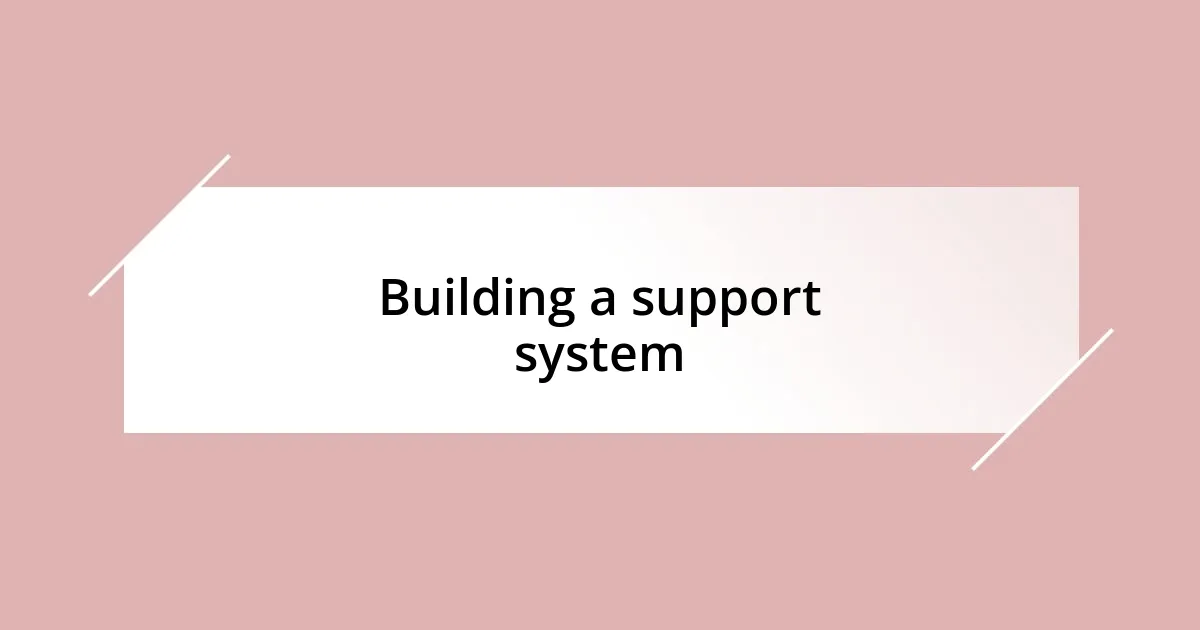Key takeaways:
- Personal empowerment involves recognizing one’s strength and actively participating in one’s treatment journey through clear communication and goal-setting.
- Building a supportive network of family, friends, and professionals enhances emotional resilience and helps navigate challenges.
- Effective self-advocacy includes preparation for appointments, documenting experiences, and maintaining open communication with healthcare providers for better collaboration.
- Tracking progress, being flexible with treatment plans, and sharing insights with healthcare teams can lead to more tailored and effective care strategies.

Understanding personal empowerment
Understanding personal empowerment is about recognizing your own strength and agency in shaping your treatment journey. I remember a time when I felt overwhelmed by the choices in my care. It was only after I started asking myself, “What do I truly want from this?” that I began to feel more in control, transforming my experience from passive to active.
Empowerment also means embracing the right to question and understand every aspect of your treatment. Have you ever felt hesitant to voice your concerns? I once stood in front of a healthcare professional, unsure if I should speak up. But I learned that articulating my thoughts not only clarified my path but also affirmed my role as an active participant in my healing process.
It’s essential to cultivate a mindset that sees setbacks as opportunities for growth. Whenever I faced a challenge, I reminded myself of the progress I had made. Isn’t it empowering to know that every small step contributes to a larger goal? This realization fuels my drive and reinforces my commitment to my treatment plan, making the journey feel less daunting and much more rewarding.

Identifying your treatment goals
Identifying your treatment goals is a crucial step in creating a personalized approach to your care. I recall sitting in a therapist’s office, unsure of what I truly wanted to achieve. Through deep reflection and open discussion, I realized that setting specific, measurable goals not only clarified my intentions but also bolstered my motivation. It’s like charting a course; without a destination, it’s easy to feel lost along the way.
To help you in this process, consider the following points when identifying your treatment goals:
- Personal Significance: What matters most to you? Think about the aspects of your life you wish to improve.
- Realistic Expectations: Are your goals achievable? Set objectives that challenge you, but remain within reach.
- Time Frame: What is your timeline? Define milestones that keep you accountable and focused.
- Support Systems: Who can help you? Identify the people or resources that can guide you in achieving your goals.
- Flexibility: Are you open to adjusting your goals? Life can be unpredictable, and being adaptable is key to staying on track.
By answering these questions, you can create a clear vision of what you want from your treatment, guiding you through each step of your journey.

Building a support system
Building a support system is one of the most transformative steps I took in my treatment plan. I can’t stress enough how vital it is to surround yourself with people who genuinely care about your well-being. When I brought my family and close friends into my journey, I noticed an immediate shift in my emotional landscape. Their encouragement gave me the strength to face challenges I once found daunting. Think about it—who in your life lifts you up when you feel down? Identifying these supportive individuals can make all the difference.
Creating a support system is not just about having people around; it’s also about finding the right balance of emotional and practical support. I learned that I could turn to my friends for informal chats about my feelings, yet needed a therapist for deeper insights into my struggles. It’s important to recognize that you might require different types of support at various stages of your journey. Have you ever felt unsure about who to reach out to? I used to be hesitant, but realizing that my support network offered diverse perspectives helped me navigate difficult moments much more effectively.
Building connections within support groups also played a crucial role in my healing. When I attended a local support group, I found a community of individuals facing similar challenges. It was a turning point for me. Sharing experiences made me feel less isolated, and the collective strength we built together was palpable. I knew I wasn’t alone in my struggles; it was like being part of a team where everyone played a role in lifting each other up. Isn’t it comforting to think that together, we can face our battles head-on?
| Type of Support | Examples |
|---|---|
| Emotional Support | Friends, family, support groups |
| Practical Support | Therapists, healthcare professionals |
| Peer Support | Support group members, online forums |

Choosing the right resources
Choosing the right resources can feel overwhelming, but it’s crucial for effective treatment. I remember the first time I scoured the internet for information; it was like drowning in a sea of choices. My advice? Pinpoint resources that resonate with your goals and values. Whether it’s books, podcasts, or professional services, aligning them with your intentions ensures they become empowering tools rather than distractions.
One valuable resource I found was a wellness app that catered specifically to my needs. It allowed me to track my progress and even offered guided meditations tailored to my anxiety levels. The consistency in using that app became a comforting routine; have you ever experienced how a small change can bring significant relief? I definitely did, feeling as though I had a personal guide with me every step of the way.
I also discovered the power of community resources, such as workshops or local seminars. Attending one of these gatherings opened me up to fresh perspectives and new strategies. It was eye-opening to hear others share their experiences and validate my own struggles. Have you surrounded yourself with the right information? Sometimes the best resource can be the voices of people who have walked a similar path, reminding us that we are not alone in this journey.

Strategies for self-advocacy
Strategies for self-advocacy
Self-advocacy starts with understanding your own needs and expressing them clearly. I remember a moment when I felt frustrated during a medical appointment because I didn’t voice my concerns. It was a learning experience that taught me the importance of speaking up. Have you ever felt your voice wasn’t heard? Finding the courage to articulate your needs can often transform the conversation and lead to better collaboration with your healthcare providers.
Another strategy I discovered was the power of preparation. Before my appointments, I began jotting down questions and concerns. This simple act made me feel more confident and organized. I vividly recall walking into my doctor’s office with a list, feeling like I had a game plan. It was such a relief to know that I was in control of the discussion. Have you tried this approach? It’s astonishing how much it can shift the dynamic when you’re equipped with concrete points to discuss.
Aside from preparation, I found that documenting my experiences and responses to treatment was invaluable. Keeping a journal allowed me to track patterns in my health and well-being over time. I think about how many times I’ve wished I could rewind and remember the specifics of a challenging day. With that journal in hand, I could provide my healthcare team with comprehensive insights, resulting in tailored treatment plans. Have you considered maintaining a record of your journey? It not only empowers you but fosters deeper engagement with your treatment process, making you an active participant in your own care.

Tracking your progress effectively
Tracking your progress effectively is an essential part of any treatment plan. I remember when I first started using a progress tracking journal. It felt humbling to put my thoughts down on paper, allowing me to see the highs and lows side by side. Have you ever felt a huge weight lifted after reflecting on your journey? It’s amazing how this simple act can reveal patterns that might otherwise go unnoticed.
Utilizing digital tools can also streamline the process. For instance, I discovered an app that not only helped me log my daily moods but also sent me reminders to check in with myself. Initially, I was skeptical, thinking, “Will this really make a difference?” However, after a few weeks, I saw tangible improvements in my emotional awareness. It turned out that technology became a bridge connecting me to my own progress.
Another powerful strategy I’ve embraced is sharing my tracking results with my healthcare provider. During my last appointment, I showed my doctor a chart I created detailing my mood fluctuations and responses to different treatments. I felt empowered being able to discuss the data, which transformed our conversation into a collaborative effort. Have you thought about how sharing your progress can enhance the care you receive? Engaging your healthcare team with your insights not only validates your experiences but also fosters a strong partnership in your healing journey.

Adjusting your plan as needed
When it comes to treatment plans, flexibility is key. I can recall a time when my initial strategy wasn’t yielding the results I hoped for. Instead of feeling defeated, I reached out to my healthcare provider and suggested a few adjustments based on my recent experiences. It was refreshing to see how they appreciated my initiative, which ultimately led to a more effective plan tailored to my needs. Have you ever felt that making a change was the right step but weren’t sure how to approach it with your team?
It’s crucial to recognize the signs that indicate your plan needs tweaking. I’ve learned to listen to my body and emotions closely. There were days when I just knew that something wasn’t working. By articulating this to my healthcare provider, I found that minor changes—like adjusting dosages or incorporating new strategies—could lead to significant improvements. How do you tune in to your body’s signals, and what changes have you made in response?
Lastly, maintaining open communication is vital for adapting your treatment plan. In my discussions with my team, I discovered that they genuinely value my input. Each conversation has been an opportunity to reassess and refine my journey. I often ask myself, “Are we on the right path?” The answers I’ve received have directly influenced my health outcomes. Have you shared your insights with your healthcare team recently? This two-way dialogue is empowering and reminds us that we are partners in the journey toward wellness.












